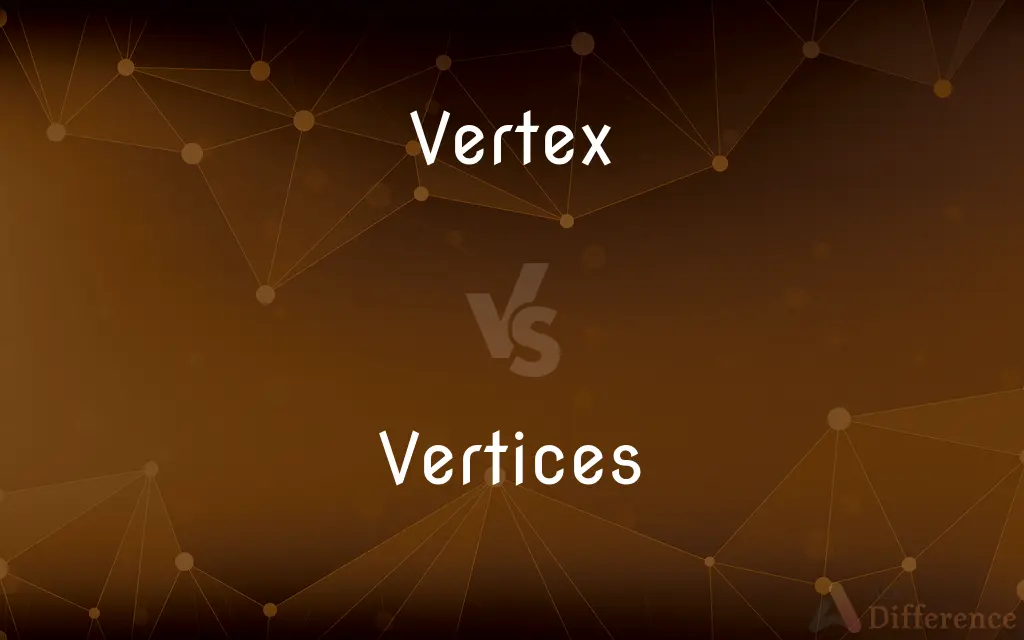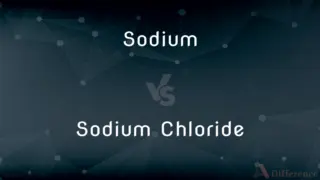Vertex vs. Vertices — What's the Difference?
Edited by Tayyaba Rehman — By Maham Liaqat — Published on April 12, 2024
"Vertex" refers to a single point where two or more lines or edges meet, commonly used in geometry and graph theory, while "vertices" is the plural form, indicating multiple such points.

Difference Between Vertex and Vertices
Table of Contents
ADVERTISEMENT
Key Differences
In geometry, a vertex is a crucial concept representing the corner point where two or more curves, lines, or edges intersect. Vertices, on the other hand, are the collection of all such points in a figure or a shape. For example, a triangle has three vertices, marking each corner where its sides meet.
In the context of shapes and polygons, a vertex serves as a defining point that helps in understanding the structure and properties of the figure. The term vertices is used to discuss all the corner points collectively, which is essential when calculating properties like perimeter, area, or when applying certain geometrical theorems.
In graph theory, a vertex represents an individual node or point within a graph, which can be connected to other nodes by edges. Vertices, in this context, refer to all the nodes in the graph, emphasizing the network's structure and the relationships between different points.
The terminology also extends to 3D geometry, where a vertex in solid figures is the point where edges meet. For example, in a cube, which has vertices at each corner where its three edges meet, these points are crucial for defining the shape and spatial properties.
Understanding the difference between vertex and vertices is fundamental in various fields such as mathematics, computer science, and architecture, as they form the basis for more complex concepts and applications.
ADVERTISEMENT
Comparison Chart
Definition
A single point where two or more lines or edges meet
The plural form of vertex, indicating multiple such points
Usage
Refers to one corner or intersection point in geometrical shapes or graphs
Used to refer to all corner or intersection points collectively
Contexts
Geometry, graph theory, computer graphics
Same as vertex, but when discussing multiple points
Example
In a triangle, each corner where two sides meet is a vertex
A square has four vertices, one at each corner
Importance
Defines individual points that are key to the structure of shapes or graphs
Emphasizes the collective set of points crucial for understanding the overall structure
Compare with Definitions
Vertex
A point where two or more lines or edges meet in a geometric shape.
Each corner of a pentagon is called a vertex.
Vertices
In graph theory, it denotes all the nodes within a graph.
The complexity of a graph is determined by its edges and vertices.
Vertex
The highest point or apex, such as the top of a mountain.
The climber aimed for the vertex of the mountain.
Vertices
The plural of vertex, referring to multiple points in a geometric shape where lines or edges converge.
A hexagon has six vertices.
Vertex
A node in graph theory representing an endpoint or a standalone point.
Every network diagram consists of vertices connected by edges.
Vertices
Used to describe the collection of apexes or high points.
The vertices of the mountain range were covered in snow.
Vertex
A point where two sides of an angle meet.
The vertex of an angle is where its two rays start from.
Vertices
Points where the sides of multiple angles meet.
The polygon's interior angles have vertices that are crucial for its geometric properties.
Vertex
The principal point of something, where everything converges.
The project's success hinged on a single vertex of decision.
Vertices
Multiple principal or focal points in a given context.
The project was at a juncture with several critical vertices needing attention.
Vertex
The highest point; the apex or summit
The vertex of a mountain.
Vertices
A plural of vertex.
Vertex
The point at which the sides of an angle intersect.
Vertices
Plural of vertex
Vertex
The point on a triangle or pyramid opposite to and farthest away from its base.
Vertex
The highest point, top or apex of something.
Vertex
(geometry) An angular point of a polygon, polyhedron or higher order polytope.
Vertex
(mathematics) A point on the curve with a local minimum or maximum of curvature.
Vertex
(graph theory) One of the elements of a graph joined or not by edges to other vertices.
Vertex
The point in any figure opposite to, and farthest from, the base; the terminating point of some particular line or lines in a figure or a curve; the top, or the point opposite the base.
Vertex
The point of intersection of lines or the point opposite the base of a figure
Common Curiosities
How do vertices affect the properties of a graph?
The arrangement and number of vertices in a graph influence its connectivity, paths, and overall structure.
How are vertices labeled in mathematics?
Vertices are often labeled with capital letters in diagrams and illustrations for clarity and reference.
Can a shape have only one vertex?
Technically, a shape must have at least three vertices to form a closed polygon, but in broader contexts like curves or angles, a single vertex can exist.
Can vertices determine the type of polygon?
Yes, the number of vertices in a polygon directly correlates with its type, such as a pentagon having five vertices.
Can moving a vertex affect a shape's symmetry?
Moving a vertex can indeed affect a shape's symmetry, altering its balanced proportions and potentially changing its symmetry type.
How are vertices used in computer graphics?
In computer graphics, vertices define the corners of 3D models and polygons, crucial for rendering shapes and objects.
Is a vertex only a part of geometric shapes?
While commonly associated with geometry, the concept of a vertex is also central to graph theory, computer graphics, and any field involving interconnected points.
Are vertices relevant in non-Euclidean geometry?
Yes, vertices are relevant in non-Euclidean geometries as well, representing points of intersection or corners in various geometric constructions.
How do vertices relate to edges in a polygon?
In a polygon, each vertex is a point where two edges meet, and the number of vertices equals the number of edges.
How does the number of vertices relate to geometric formulas?
Many geometric formulas, such as those for calculating the sum of interior angles, depend on the number of vertices in a polygon.
Are vertices used in topology?
In topology, vertices are used in the study of topological spaces, albeit in a more abstract sense than in traditional geometry.
How do vertices contribute to the study of polyhedra?
Vertices are fundamental in studying polyhedra, as they, along with edges and faces, define the structure and properties of these 3D figures.
Can vertices change the shape of a polygon?
Altering the position of vertices while keeping the number of sides constant can change a polygon's shape but not its classification.
Can the term vertex apply to 3D shapes?
Yes, in 3D shapes, a vertex is where three or more edges meet, defining corners of polyhedra.
What role do vertices play in the calculation of angles?
Vertices are pivotal points from which angles are measured or defined in geometric figures.
Share Your Discovery

Previous Comparison
Laser Mouse vs. Optical Mouse
Next Comparison
Sodium vs. Sodium ChlorideAuthor Spotlight
Written by
Maham LiaqatEdited by
Tayyaba RehmanTayyaba Rehman is a distinguished writer, currently serving as a primary contributor to askdifference.com. As a researcher in semantics and etymology, Tayyaba's passion for the complexity of languages and their distinctions has found a perfect home on the platform. Tayyaba delves into the intricacies of language, distinguishing between commonly confused words and phrases, thereby providing clarity for readers worldwide.













































